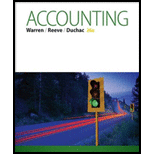
Accounting (Text Only)
26th Edition
ISBN: 9781285743615
Author: Carl Warren, James M. Reeve, Jonathan Duchac
Publisher: Cengage Learning
expand_more
expand_more
format_list_bulleted
Question
Chapter 15, Problem 15.11EX
(a)
To determine
Equity investment: Equity investments are stock instruments which claim ownership in the investee company and pay a dividend revenue to the investor company.
Equity method: Equity method is the method used for accounting equity investments which claim a significant influence of above 20% but less than 50% in the outstanding stock of the investee company.
Debit and credit rules:
- Debit an increase in asset account, increase in expense account, decrease in liability account, and decrease in
stockholders’ equity accounts.
- Credit decrease in asset account, increase in revenue account, increase in liability account, and increase in stockholders’ equity accounts.
To journalize: The stock investment transactions for Company S, under the equity method
(b)
To determine
The stock investment balance for Company S
Expert Solution & Answer
Want to see the full answer?
Check out a sample textbook solution
Students have asked these similar questions
Please answer the following requirements on these financial accounting question
Please provide accurate answer
No use ai
hello tutor
Chapter 15 Solutions
Accounting (Text Only)
Ch. 15 - Why might a business invest cash in temporary...Ch. 15 - What causes a gain or loss on the sale of a bond...Ch. 15 - When is the equity method the appropriate...Ch. 15 - How does the accounting for a dividend received...Ch. 15 - Prob. 5DQCh. 15 - What is the major difference in the accounting for...Ch. 15 - Prob. 7DQCh. 15 - How would a debit balance in Unrealized Gain...Ch. 15 - What are the factors contributing to the trend...Ch. 15 - Prob. 10DQ
Ch. 15 - Prob. 15.1APECh. 15 - Bond investment transactions Journalize the...Ch. 15 - Prob. 15.2APECh. 15 - Stock investment transactions On September 12,...Ch. 15 - Prob. 15.3APECh. 15 - Prob. 15.3BPECh. 15 - Prob. 15.4APECh. 15 - Prob. 15.4BPECh. 15 - Prob. 15.5APECh. 15 - Prob. 15.5BPECh. 15 - Prob. 15.6APECh. 15 - Prob. 15.6BPECh. 15 - Prob. 15.1EXCh. 15 - Prob. 15.2EXCh. 15 - Prob. 15.3EXCh. 15 - Prob. 15.4EXCh. 15 - Prob. 15.5EXCh. 15 - Entries for investment in stock, receipt of...Ch. 15 - Prob. 15.7EXCh. 15 - Prob. 15.8EXCh. 15 - Entries for stock investments, dividends, and sale...Ch. 15 - Prob. 15.10EXCh. 15 - Prob. 15.11EXCh. 15 - Prob. 15.12EXCh. 15 - Prob. 15.13EXCh. 15 - Prob. 15.14EXCh. 15 - Prob. 15.15EXCh. 15 - Prob. 15.16EXCh. 15 - Fair value journal entries, trading investments...Ch. 15 - Prob. 15.18EXCh. 15 - Prob. 15.19EXCh. 15 - Prob. 15.20EXCh. 15 - Prob. 15.21EXCh. 15 - Prob. 15.22EXCh. 15 - Prob. 15.23EXCh. 15 - Prob. 15.24EXCh. 15 - Prob. 15.25EXCh. 15 - Prob. 15.26EXCh. 15 - Prob. 15.27EXCh. 15 - Prob. 15.28EXCh. 15 - Prob. 15.29EXCh. 15 - Prob. 15.1APRCh. 15 - Prob. 15.2APRCh. 15 - Stock Investment transaction, equity method and...Ch. 15 - Prob. 15.4APRCh. 15 - Prob. 15.1BPRCh. 15 - Prob. 15.2BPRCh. 15 - Stock investment transactions, equity method and...Ch. 15 - Prob. 15.4BPRCh. 15 - Selected transactions completed by Equinox...Ch. 15 - Benefits of fair value On July 16, 1998, Wyatt...Ch. 15 - International fair value accounting International...Ch. 15 - Prob. 15.3CPCh. 15 - Warren Buffett and "look-through" earnings...Ch. 15 - Prob. 15.5CP
Knowledge Booster
Similar questions
- Cost of goods sold ? Financial accountingarrow_forwardWhat is the target cost per bread slicer on these financial accounting question?arrow_forwardDuring the current year, a business sells equipment for $440,000. The equipment cost $290,000 when purchased and placed in service two years ago and $85,000 of depreciation deductions were allowed. The results of the sale are ____. OPTIONS: A) Ordinary income of $85,000 and Sec. 1231 gain of $150,000. B) Sec. 1231 gain of $120,000. C) Ordinary income of $90,000 and LTCL of $30,000. D) Ordinary income of $120,000. Select the correct answer✅arrow_forward
arrow_back_ios
SEE MORE QUESTIONS
arrow_forward_ios
Recommended textbooks for you
 Financial & Managerial AccountingAccountingISBN:9781285866307Author:Carl Warren, James M. Reeve, Jonathan DuchacPublisher:Cengage Learning
Financial & Managerial AccountingAccountingISBN:9781285866307Author:Carl Warren, James M. Reeve, Jonathan DuchacPublisher:Cengage Learning Financial AccountingAccountingISBN:9781305088436Author:Carl Warren, Jim Reeve, Jonathan DuchacPublisher:Cengage Learning
Financial AccountingAccountingISBN:9781305088436Author:Carl Warren, Jim Reeve, Jonathan DuchacPublisher:Cengage Learning Financial Accounting: The Impact on Decision Make...AccountingISBN:9781305654174Author:Gary A. Porter, Curtis L. NortonPublisher:Cengage Learning
Financial Accounting: The Impact on Decision Make...AccountingISBN:9781305654174Author:Gary A. Porter, Curtis L. NortonPublisher:Cengage Learning EBK CONTEMPORARY FINANCIAL MANAGEMENTFinanceISBN:9781337514835Author:MOYERPublisher:CENGAGE LEARNING - CONSIGNMENT
EBK CONTEMPORARY FINANCIAL MANAGEMENTFinanceISBN:9781337514835Author:MOYERPublisher:CENGAGE LEARNING - CONSIGNMENT Excel Applications for Accounting PrinciplesAccountingISBN:9781111581565Author:Gaylord N. SmithPublisher:Cengage Learning
Excel Applications for Accounting PrinciplesAccountingISBN:9781111581565Author:Gaylord N. SmithPublisher:Cengage Learning

Financial & Managerial Accounting
Accounting
ISBN:9781285866307
Author:Carl Warren, James M. Reeve, Jonathan Duchac
Publisher:Cengage Learning

Financial Accounting
Accounting
ISBN:9781305088436
Author:Carl Warren, Jim Reeve, Jonathan Duchac
Publisher:Cengage Learning

Financial Accounting: The Impact on Decision Make...
Accounting
ISBN:9781305654174
Author:Gary A. Porter, Curtis L. Norton
Publisher:Cengage Learning


EBK CONTEMPORARY FINANCIAL MANAGEMENT
Finance
ISBN:9781337514835
Author:MOYER
Publisher:CENGAGE LEARNING - CONSIGNMENT

Excel Applications for Accounting Principles
Accounting
ISBN:9781111581565
Author:Gaylord N. Smith
Publisher:Cengage Learning